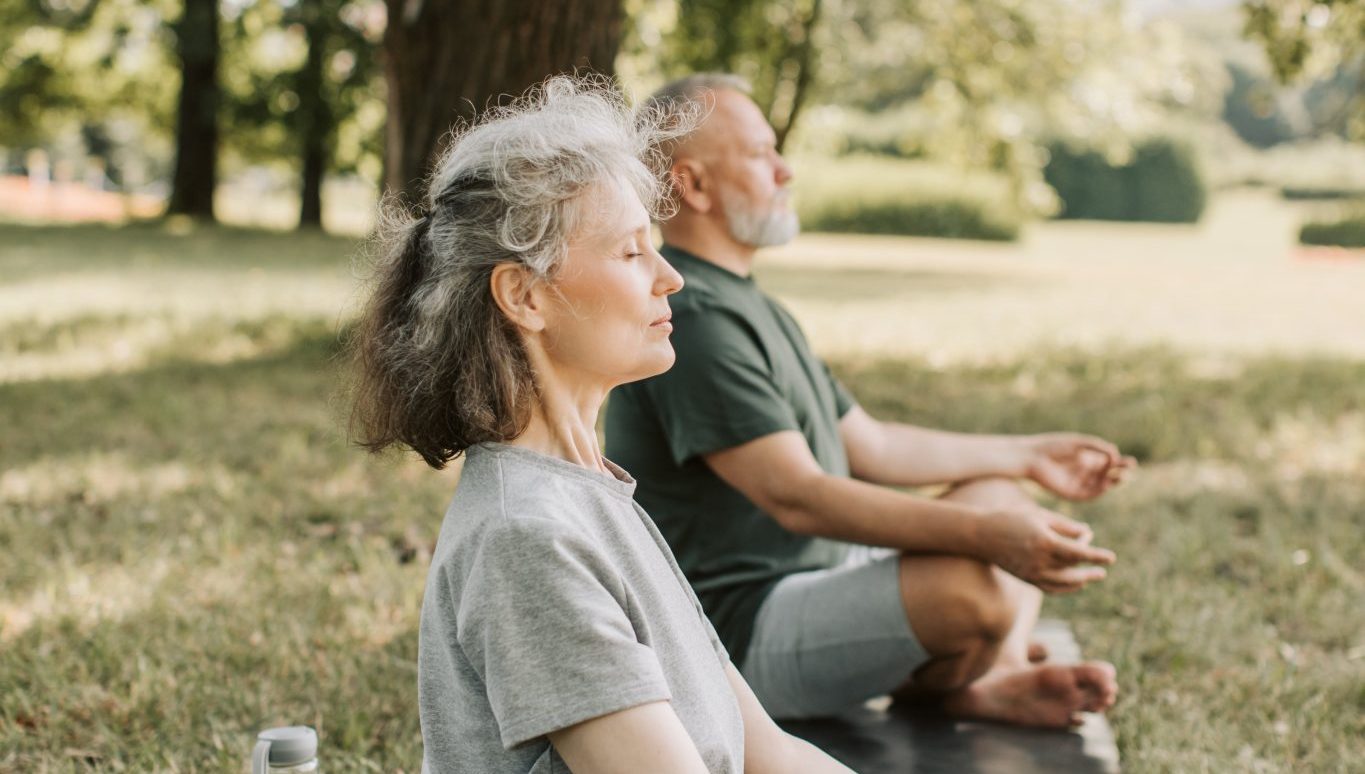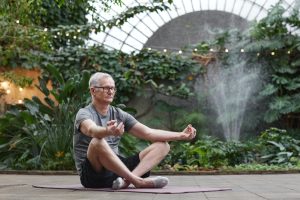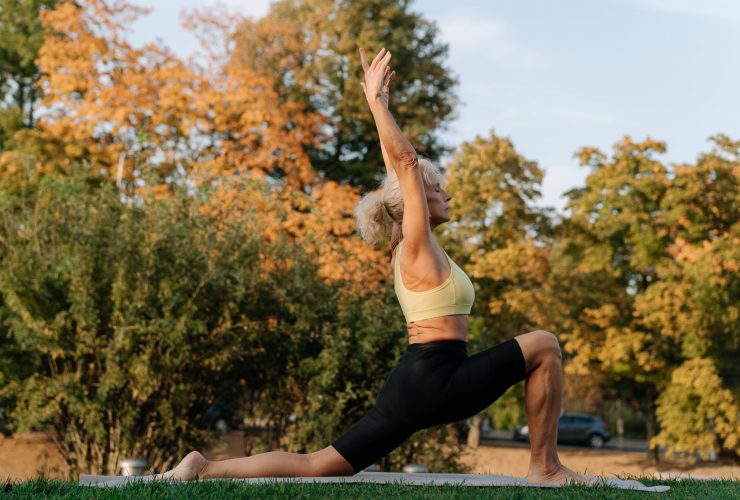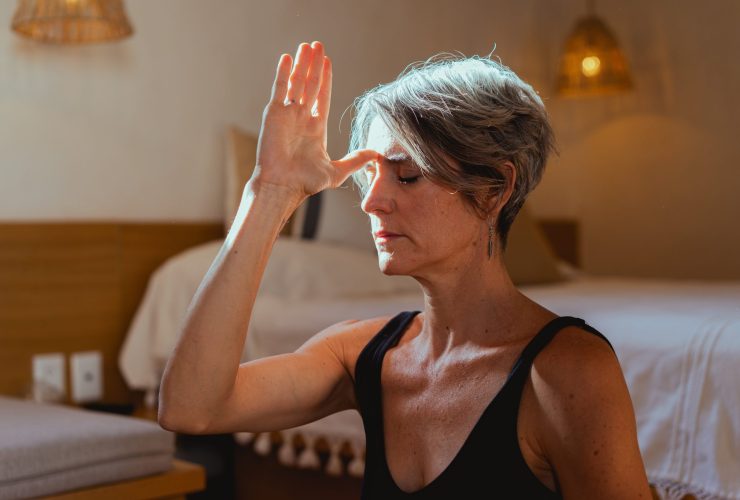As you grow older, you have probably received advice on how to “age gracefully” or “stay young for longer”. From magazines to friends and family, everyone seems to have an opinion. While there is nothing wrong with growing older—it is a natural part of life, after all—it does come with a lot of fear, turmoil, and resistance, and many will try to find methods to stay youthful. However, accepting your age and all of the challenges that come along with it is essential to navigating the journey of aging.
One method, well known for its benefits for people of all ages, is mindfulness. Encompassing practices such as meditation, yoga, and journaling, mindfulness has been linked to benefits such as increased cognitive clarity, lower blood pressure, and improved digestion. For seniors, the low physical requirements of meditation in particular provides an accessible way to improve quality of life, both mentally and physically—it can also set seniors on the path towards age acceptance.
What is mindfulness?
Mindfulness is defined as the quality or state of being conscious or aware of something, according to Oxford Languages. This state is at the core of mindful practices such as meditation, where the practitioner focuses on becoming conscious of their surroundings in a calm, non judgemental way. The goal of meditation—and mindfulness in general—is to be fully aware and accepting of the present moment.
Mindful practices have been around for thousands of years, with meditation in particular showing up across most major religions and cultures. Psychology Today estimated that meditative practices began as early as 5,000 BCE in the Indus Valley, where ancient wall art depicting people meditating has been found. From there, the art of meditation is thought to have followed the Silk Road, branching out and changing slightly to fit cultures throughout Asia.
Today, meditation is more popular than ever. From simple guided meditations on YouTube to multi-day meditation retreats, there is something for everyone. Many modern-day religions also utilize mindfulness, with the most well known of these applications being Buddhist meditations; however, mindfulness is also included in Hinduism, Christianity, and more. Mindfulness is even recognized by the World Health Organization as a form of stress relief.
Benefits of mindfulness for seniors
Health conditions usually have both physical and mental symptoms. For example, anxiety—one of the most common mental health issues in seniors—is a mental condition which can also cause physical issues. These physical signs include things such as an increased heart rate, trembling, and weight loss. Because of the multi-faceted nature of many health conditions, an ideal treatment plan should have both mental and physical benefits.
Mental benefits
Much research has been conducted on the effects of mindfulness on older adults. According to a review published on the National Library of Medicine website, meditation and other mindfulness-based interventions have been associated with “significant declines in loneliness, depression, anxiety, stress, sleep problems, and rumination.” Along with this, “significant increases in general mood and positive affect” have also been seen. For older adults struggling with mental health issues, meditation can be used to ease some of their symptoms, or make them easier to accept and live with. While meditation does not replace formal treatments such as therapy and medication, it can be used in conjunction with these methods to achieve better results.
Meditation has also shown promising results in combating cognitive decline in seniors. One particular NCBI study found a “small but significant effect on cognitive function” in adults aged 60 and above; this research suggests that mindfulness’ focus on strengthening mental skills likely has positive effects on cognition. Beyond these studies, personal anecdotes have reported that seniors who meditate feel less burdened by negative emotions, and are more patient, concentrated, and creative.
Mindfulness may also be able to alleviate symptoms of another common age-related condition: dementia. According to the Alzheimer’s Society of Canada, there are an estimated 733,000 people in Canada currently living with some form of dementia, and this number is expected to rise to 1,700,000 people by 2050. With no known cure, many seniors have reported feeling anxious about the possibility of developing this condition. Preventative measures are limited and have not been formally proven. Currently, the general advice is to remain mentally and physically active, fit, and make healthy choices to reduce blood pressure and maintain your overall well being.
As meditation has been shown to aid in the management of other mental conditions, several studies have looked into its possible benefits for those with dementia. According to a review by researchers on PubMed, this research has shown “preliminary but promising results” for the benefits of mindfulness-based interventions—not just for those with dementia, but also for their caregivers.
Physical benefits
Mindfulness has the word “mind” in it, and therefore is often thought of as having only mental benefits; however, several studies have found that it can bring about positive physical changes as well. In a 2023 PubMed article, it was noted that meditation has benefited those with diabetes, hypertension, and fibromyalgia. Their study also found evidence of DNA-level benefits, with lengthened telomeres—proteins which protect your chromosomes—leading to overall healthier cellular aging. Some chemical changes were also observed on genes relating to immune metabolism, which has led researchers to believe that meditation can improve our immune systems.
Also among the effects of meditation are an improved blood pressure, and lowered cholesterol levels in the blood. Notably, meditation has been linked to the increase of “good cholesterol” or high-density lipoproteins, which actually help to remove “bad cholesterol” from the bloodstream. Over time, this can reduce the risks of heart attacks and strokes, which are both common in seniors. In fact, according to the Medical University of South Carolina, 75% of strokes occur in adults 65 or older. And, as mentioned earlier, lowered blood pressure is thought to reduce the likelihood of developing dementia!
One final physical benefit is meditation’s anti-inflammatory properties, which are especially beneficial for seniors. With age, many chronic inflammatory conditions can develop or worsen. One common example is rheumatoid arthritis (RA), which causes inflammation in the joints. This usually begins between the ages of 30 ~ 60, and affects the finger and foot bones first, then progresses to the wrists, elbows, hips, and knees. While meditation will not have as much of an effect as anti-inflammatory medication, it can still be a beneficial method of combating RA. This is especially true as, according to several NCBI studies, RA has been shown to be worsened by depressive states; therefore, meditation’s mental benefits also translate into physical benefits.
Age acceptance
As mentioned in the beginning of this article, aging can be a scary and tumultuous thing. Losing mobility, experiencing cognitive decline, and becoming less independent can take a serious toll on many seniors. Since mindfulness is centered around the acceptance of the present moment, many older adults have found it to be very helpful in their quests to find peace in aging; they are able to accept what they cannot change, while noticing and working on the things they can.
How to implement mindfulness into your life
After learning about the benefits of mindfulness, you are likely wanting to implement it into your life. Luckily, mindfulness has many forms, and can be incorporated into any lifestyle. From meditation with low physical demand, to yoga and other active forms, there is something for everybody.
Meditation
One of the most accessible forms of mindfulness is meditation. The central practice in meditation is the act of noticing what is happening in the body and mind without judgement. Generally, this is done in a seated position, but can be done laying down as well, making it a mindfulness practice with a low physical toll—perfect for seniors with joint pain or mobility issues.
There are several forms of meditation. The most beginner-friendly form is a simple breath-focused meditation; practitioners will focus on their breath as it flows in and out, gently returning their focus back to the breath whenever they get distracted. This allows for a deeper understanding of the body, the breath, and how thoughts come and go—leading to less anxiety, and a sense of peace and calmness. Breathing meditation can be done in any position, whether that be sitting in bed or on a chair, or laying down.
For those looking to relax their bodies completely, body scan meditations are another option. This form of meditation has practitioners systematically examine the sensations felt in their bodies from top to bottom. For example, one might focus on the sensations felt at the top of their head, and then gradually work all the way down to their toes. The goal is to remain impartial, and also to only focus on one area at a time—the rest is irrelevant. Seniors experiencing stiffness, aching joints, or any other type of pain will likely find this helpful, as it can train the mind to be more accepting of discomfort.
Finally, there are guided meditations. These usually incorporate aspects of both breath-focused and body scan meditations, and can be done through classes in person, online, or using a video or recording. The meditation guides may choose to follow a sequence similar to body scans, encouraging practitioners to relax each part of their body, or may use a mind-mapping technique to notice, identify, and release thoughts as they come up. For those who struggle with insomnia—a common complaint in older adults—guided sleep meditations can be used to help relax the body and fall asleep faster.
Mindful exercise
Mindfulness isn’t just meditation. For seniors looking to stay active not just mentally, but physically as well, mindful exercise is a fantastic way to do so. While the most well-known form of mindful exercise is yoga, things like tai chi and even just walking have similar benefits.
Yoga is thought to have originated in ancient India, just like meditation. While modern western yoga focuses largely on physical movement, traditional yoga was very similar to meditation, focusing on releasing worldly attachments. Elements of this have carried on to today, with some practitioners incorporating meditations at the beginning and / or end of their yoga sessions. Yoga has shown benefits for rheumatoid arthritis, muscle soreness, tightness, and mental health in seniors. For those with mobility issues, there are several yoga positions and sequences—called flows—which can be done from a seated position.
Tai chi, a practice which originated in ancient China, has similarities to yoga. According to Harvard Health, tai chi’s benefits include balance, flexibility, and increased stamina. In China and around the world, tai chi is popular among seniors for its loose, flowing movements which do not cause strain. Many regions will offer tai chi classes, which are often held outdoors to enjoy greenspace and to build a sense of community. And, just like yoga, many movements can be done from a seated position.
Even a simple walk can become a mindful activity if done with intention. You might try focusing on the sensations in your feet, like a small-scale body scan meditation. This heightened awareness can build focus, mental resilience, and keep you from going into “autopilot” when out on a walk. After all, mindfulness is simply the act of noticing sensations, thoughts, and feelings in a calm and non judgemental way. It doesn’t have to be more complicated than that.
Mindful activities
Mindfulness can be incorporated into everyday activities just as it can be incorporated into a walk. An example of this is mindful journaling, or journaling with the intention of noticing the emotions and thoughts that come up as you write. When reflecting on the day before, or planning for the day ahead, many thoughts will come up; mindful journaling simply involves observing these thoughts as they come and go from your mind.
Other activities which can be done mindfully include colouring, gardening, writing, drawing, listening to or playing music, and many others. In truth, any activity that involves sensations which you can focus on can be done mindfully. Take cooking, for example. As you add each ingredient, you can focus on how the smells change, or what thoughts are associated with them. Colouring can be made mindful by dedicating your full attention to the task at hand, and gently bringing the attention back should it have wandered. Doing normal activities with increased mindfulness is a fantastic way for seniors to incorporate it into their lifestyles, as it does not involve a lot of drastic change.
How to stick with mindfulness
Starting to practice mindfulness is just the first step. Continuing to build the habit until you have a consistent practice is the real goal. As with any other habit, the trick is to start small, and build from there. Try meditating for just 1 or 2 minutes a day; it may seem small, or insignificant, but the aim is to build a habit and establish a strong foundation. If the practice is not resonating with you, you can always try another activity. Choosing something that you enjoy is crucial to building consistency.
Once you have settled on one or multiple activities that you enjoy, you can play around with increasing the length of time spent on that practice. For seniors who live alone, try including friends or families in your practice—mindfulness can become a great bonding exercise and broaden your social circle. Yoga classes, group meditation sessions, and shared art classes are just some of the many great options to consider.
Above all, it is important to be gentle with yourself. By taking small steps in the right direction, and not letting any mistakes set you back, you will be able to make lasting positive changes to your lifestyle. Meditation and mindfulness are great tools; the key thing is being intentional with how you use those tools.









